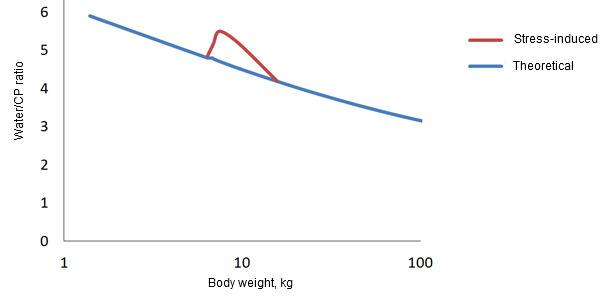Newly-weaned piglets commonly have a feed efficiency around 1 in the first week after weaning. This figure is often used to underscore the high quality of diets that are fed to these pigs. The bizarre thing is that calculating through these numbers reveals something completely different: this feed efficiency is a sign of a health problem, and nothing to be proud of!

|
Some hypothetical math: A typical piglet weaned at 21 days of age weighs 6 kg. Its maintenance energy requirement is thus 60.75 x 100 kcal = 383 kcal. Using a diet with 3.35 Kcal/kg ME, this equates to a maintenance feed intake of 115 g/day. |
Maintenance, though, assumes that this piglet is lying quietly, which is far from the truth. If we assume that because of stress this piglet functions at 1.5x maintenance, then this piglet needs to eat 172 g per day or 1.2 kg over the first week post weaning in order to have a zero energy balance. These figures are pretty much in line what is seen in practice: feed intakes around 1 kg in the first week post weaning are common.
But now the contradiction; this calculation yields an energy balance of 0. Thus, our piglet is not gaining or loosing energy in its first week post weaning. This practically means that the piglet is not growing. Not growing means that the gain to feed calculation should read 0/1 kg/kg, which gives a 0 for our G/F (and the FCR would be impossible (1/0)).
So why is this piglet growing with a feed efficiency of 1 then? One answer I have gotten from several experts is that this piglet is losing fat and using this energy for accreting protein. Although this is not supported by textbooks, there is likely some truth to this (and supported by unpublished indirect calorimetry work from Wageningen University). The maintenance requirement for growing animals is likely different for both fat and protein, with fat accretion having a higher maintenance requirement than protein accretion. Hypothetically, let’s assume that the maintenance requirement for protein is 70 kcal/kg0.75, and for fat accretion 120 kcal/kg0.75, and again an activity factor of 1.5. Using those coefficients, our piglet needs to consume 130 g/d, or 0.9 kg/week for zero gain (at which point the piglet would gain lean and loose fat). Assuming this piglet would eat twice that, it theoretically could gain 124 g/d, for a gain/feed of 0.47. Not even close to 1!
So what is going wrong? Our calculations, or the piglet? Although the above calculations are approximations only, the problem is with the piglet. The factor that is completely ignored is that newly weaned piglets develop edema; they retain water in their tissues above what is normal. The graph below illustrates this. The blue line is the ‘normal’ water/protein ratio of swine from birth to finish (after Emmans). At birth, the muscles in a pig have a relatively high water content. This explains in part the very efficient weight gain of young animals. When the pig gets older, the water/protein ratio decreases and with that feed efficiency also drops. After weaning, though, the piglet deviates from this blue line. Water is retained in its muscles above what is normal and this explain the abnormal gain of the piglet in the first days after weaning; it explains the abnormal feed efficiency.

Figure 1: Water/protein ratio in swine from birth to finish (X-axis is a log scale; after Emmans et al., 1995),
and the deviation that occurs following weaning (demonstrated by e.g., Shields et al., 1983).
The interesting question is why this edema occurs. Unfortunately, I am not aware of research in swine that has clarified this. In humans, edema is quite common in athletes that push themselves to the limit. The cause of this edema is likely oxidative stress and shifts in albumin and minerals from their regular location into tissues or into cells. This albumin and these minerals have osmotic properties and they cause fluid accumulation in their new location. What is not yet clear is if this is a protective mechanism, or a result of tissue damage. It can also be from excessive water consumption. In athletes, this edema typically disappears after several days with no evidence of permanent damage, although it can be fatal in some.

In newly weaned piglets, this edema can be prevented by having better nutritional management around weaning. E.g., by providing liquid diets and by preventing excessive water consumption, feed efficiencies can be normalized. The big question is if this would be a step in the right direction. It sounds healthier, but as long as we are aiming for feed efficiencies of 1 in the first week post-weaning, it certainly won’t be adopted by the industry.


